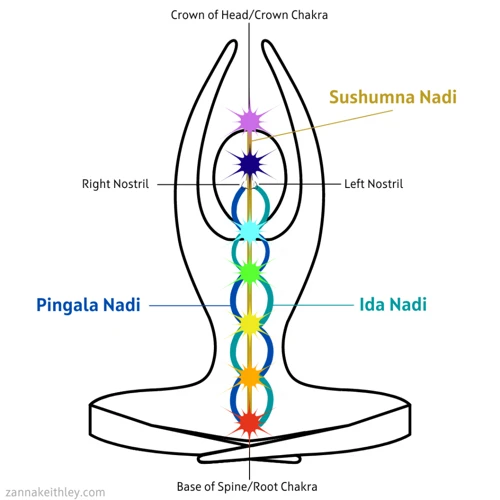As we navigate through the complexities of modern-day living, we often find ourselves feeling overwhelmed and drained. We constantly seek new tools and techniques to help us balance our mind and body, and lead a more fulfilling life. One such practice that has gained popularity in recent years is “Alternate Nostril Breathing”. This simple yet powerful technique has been used in ancient Yoga traditions for taking control of the breath, channelizing energy, and balancing the nervous system. In this article, we will explore the science, benefits, and steps to practice alternate nostril breathing, so you can include it in your daily routine and reap the benefits of a calmer, more centered self.
What is alternate nostril breathing?

Breathing is an essential bodily function that allows us to supply oxygen to our organs and tissues. But did you know that the way we breathe can affect both our physical and mental health? This is where alternate nostril breathing comes in – a powerful breathing technique that has been used for centuries in various yoga and meditation practices. But what exactly is alternate nostril breathing and how does it work? In essence, this practice involves breathing through one nostril at a time, while holding the other nostril closed. Let’s dive deeper into the details of how to do alternate nostril breathing and its many benefits.
How to do Alternate Nostril Breathing
Are you ready to try the powerful practice of alternate nostril breathing? Follow these step-by-step instructions to learn how:
| Step 1: | Sit in a comfortable position, with your spine straight and your chin parallel to the floor. |
| Step 2: | Rest your left hand on your left knee, with your palm facing up. |
| Step 3: | Place the tips of your index and middle fingers of your right hand on your third eye, located between your eyebrows. |
| Step 4: | Your right thumb should be positioned just beside your right nostril, and your right ring finger and pinky should be beside your left nostril. |
| Step 5: | Close your right nostril with your right thumb and inhale deeply through your left nostril. |
| Step 6: | Once you have fully inhaled, close your left nostril with your right ring finger and pinky, and exhale through your right nostril. |
| Step 7: | Keeping your left nostril closed, inhale through your right nostril. |
| Step 8: | Once you have fully inhaled, close your right nostril with your right thumb and exhale through your left nostril. |
| Step 9: | This completes one round. Start with 5-7 rounds and gradually increase to 10-15 rounds. |
Remember to focus on your breath and stay present throughout the practice. You may find that the rhythm of your breath changes as you progress. Don’t worry, this is perfectly normal. If you feel comfortable, try to extend the duration of each inhalation and exhalation. To avoid dizziness or discomfort, don’t force your breath. Alternate nostril breathing is meant to be a relaxing and gentle practice, so allow your body to guide you.
Benefits of Alternate Nostril Breathing
Alternate nostril breathing, also known as Nadi Shodhana, is a powerful practice that can bring numerous benefits to the mind and body. Here are some of the benefits of this practice:
- Reduces Stress: Alternate nostril breathing helps to calm the mind and reduce stress levels. When we take slow, deep breaths, we activate the parasympathetic nervous system, or “rest and digest” system, which helps to counteract the effects of stress on the body.
- Improves Lung Function: This practice promotes deep breathing, which helps to expand the lungs and increase oxygen intake. It also helps to clear the nasal passages, making it easier to breathe.
- Boosts Immune System: Some research suggests that alternate nostril breathing may stimulate the immune system, which can help to protect the body from illness and disease.
- Enhances Mental Clarity: Through the balancing of the left and right hemispheres of the brain, alternate nostril breathing can bring greater mental clarity and focus.
- Relieves Anxiety: This practice can be especially helpful for those who suffer from anxiety. The slow, conscious breathing helps to calm the nervous system and reduce feelings of anxiety and overwhelm.
- Supports Heart Health: Some studies have suggested that alternate nostril breathing may lower blood pressure and reduce the likelihood of heart disease.
- Brings a Sense of Balance and Harmony: Nadi Shodhana translates to “channel cleansing”. By balancing the flow of energy in the body, this practice can bring a sense of harmony and balance to both the body and mind.
By incorporating this practice into your daily routine, you may start to notice some of these benefits for yourself.
The Science Behind Alternate Nostril Breathing

As we delve deeper into the practice of alternate nostril breathing, it’s worth considering the scientific basis for its effectiveness. The benefits of this ancient yogic technique are not only spiritual, but also backed by modern scientific research that sheds light on the physiological changes that occur when we engage in this practice. In this section, we’ll explore the role of the nervous system in regulating stress and how alternate nostril breathing can help bring balance to the body and mind. We’ll also touch on the concept of prana and chakras and their connection to our overall health and wellbeing.
The Nervous System and Stress
The nervous system plays a crucial role in managing stress in our daily lives. It is responsible for controlling our body’s response to stress and activating the appropriate physiological systems to maintain homeostasis. Chronic stress can lead to issues such as anxiety, depression, high blood pressure, and other health problems.
There are two main branches of the nervous system – the sympathetic nervous system and the parasympathetic nervous system. The sympathetic nervous system is responsible for the “fight or flight” response, which prepares our body to face a perceived threat. The parasympathetic nervous system, on the other hand, is responsible for the “rest and digest” response, which allows our body to conserve energy and recover from stress.
When we’re under stress, the sympathetic nervous system is activated, which leads to an increase in heart rate, blood pressure, and breathing rate. This response is designed to help us respond to a perceived threat quickly, but if it’s activated frequently, it can lead to long-term health problems. That’s where alternate nostril breathing can be helpful.
Through its ability to activate the parasympathetic nervous system, alternate nostril breathing can help to bring balance to the body and reduce the negative effects of chronic stress. This technique has been shown to help reduce anxiety and depression, improve cardiovascular function, and increase feelings of relaxation and well-being.
To understand how alternate nostril breathing works to support the parasympathetic nervous system, it’s important to understand the role of the breath in our physiological response to stress.
| The Role of Breath in the Stress Response |
|---|
| During periods of stress, our breath becomes shallow and rapid. This leads to a decrease in oxygen and an increase in carbon dioxide levels in the body. |
| This imbalance can increase feelings of anxiety, tension, and stress. By practicing alternate nostril breathing, we can balance the flow of oxygen and carbon dioxide in the body, which can help to reduce feelings of stress and anxiety. |
By incorporating alternate nostril breathing into your daily practice, you can support your body’s natural ability to manage stress and improve your overall sense of well-being.
The Role of Prana and Chakras
According to ancient Indian philosophy, prana is the vital energy present in all living things. The Sanskrit word prana roughly translates to “life force” or “vital energy”. Prana is believed to flow through the body’s channels, or nadis, and can be controlled through breathwork practices such as alternate nostril breathing.
Indian philosophy also recognizes the existence of chakras, which are energy centers that exist along the spine. The seven main chakras are believed to impact various aspects of our physical, emotional, and mental well-being. Each chakra is associated with specific organs, emotions, and qualities.
The practice of alternate nostril breathing is believed to balance the flow of prana through the chakras, resulting in a harmonious and balanced mind and body. This is because the right nostril is associated with the “pingala” nadi, which correlates with the sympathetic nervous system and the “masculine” energy in our body. The left nostril, on the other hand, is associated with the “ida” nadi, which correlates with the parasympathetic nervous system and the “feminine” energy in our body.
By alternating between breathing through each nostril, we can balance the flow of energy in our body, resulting in a harmonized state of being. Additionally, the practice of alternate nostril breathing is believed to activate the third eye chakra, which is associated with inner wisdom and intuition.
Incorporating alternate nostril breathing into your daily practice can help balance the flow of prana through your chakras, resulting in a more harmonious mind and body.
How to incorporate alternate nostril breathing into your daily practice
Now that you understand the technique and the benefits of Alternate Nostril Breathing, it’s time to incorporate it into your daily practice. This powerful and time-tested practice is simple enough to do anywhere, and its benefits extend beyond just relaxation and stress relief. With consistent practice, it’s possible to experience a deeper sense of balance, focus, and vitality in both the mind and body. Let’s explore some tips on how to incorporate this practice into your daily routine.
Creating a Regular Practice
Incorporating alternate nostril breathing into your daily routine can have numerous benefits for your mind and body. Here are a few steps you can take to create a regular practice of this technique:
- Set aside time: Find a time during the day when you can devote at least 5-10 minutes to your practice. This could be in the morning before starting your day, during a break at work, or before bedtime to help you relax before sleep.
- Find a comfortable position: Sit comfortably in a chair or on the floor with your back straight and shoulders relaxed. You can also lie down if that feels better for you.
- Breathe normally: Take a few deep breaths to relax and start to focus on your breath. Then, using your right hand, bring your thumb to your right nostril and your ring and pinky fingers to your left nostril.
- Begin the practice: Close your right nostril with your thumb and inhale deeply through your left nostril. Close your left nostril with your ring and pinky fingers, release your thumb from your right nostril, and exhale deeply through your right nostril. Inhale deeply through your right nostril, then close it with your thumb and release your left nostril to exhale through it. This completes one round of alternate nostril breathing.
- Repeat: Repeat this process for several rounds. You can start with just a few at first and gradually increase the number as you become more comfortable with the technique.
By making a regular practice of alternate nostril breathing, you may experience reduced stress and improved focus and mental clarity. It can also help to balance the energy flow in your body, promoting overall wellbeing. Remember to listen to your body and adjust the technique as needed to ensure your comfort and safety.
What to Expect in your Practice
Performing the alternate nostril breathing technique may require some practice and to help you stay motivated during your practice, here are some things you should expect:
| Expectation | Description |
|---|---|
| Frustration | Don’t worry if you find it difficult to breathe from one of your nostrils at first. This is common, and it may take some time to get used to the technique. |
| Relaxation | You’ll start to notice a feeling of relaxation and calmness throughout your body as you practice the technique. This is one of the immediate benefits of exercise. |
| Improved Concentration | With regular practice, you’ll find that your focus and concentration improve. You may even find that your memory improves as well, due to the increased oxygen flow to your brain. |
| Improved Mood | You may notice an improvement in your mood, as the technique is known to help alleviate stress and anxiety, and increase feelings of happiness and well-being. |
| Better Sleep | If you practice alternate nostril breathing before bed, you may find that it helps you sleep better. The relaxation and reduction of stress and anxiety can help you get a more restful night’s sleep. |
Remember that everyone’s experience may be different, so it’s important to be patient and consistent with your practice. Over time and with regular practice, you’ll begin to see the benefits of this powerful technique.
Conclusion
In conclusion, alternate nostril breathing is a powerful practice that can bring balance to both the mind and body. By regulating the breath through the nasal passages and activating both hemispheres of the brain, this technique can help to reduce stress, calm the mind, and promote overall well-being.
Through its connection to the nervous system and the body’s energy centers, alternate nostril breathing offers a deeper understanding of the mind-body connection and the importance of maintaining balance within ourselves.
Incorporating this practice into a regular daily routine can be transformative, helping to cultivate a sense of inner peace, improve mental clarity and focus, and deepen overall awareness. It is important to approach this technique with an open mind and a willingness to embrace the journey toward self-discovery and self-improvement.
As with any new practice, it takes time and patience to fully appreciate the benefits of alternate nostril breathing. But with consistent effort and a commitment to self-care, this powerful tool can become an invaluable part of our daily lives, helping us to better manage stress and strengthen our mind-body connection.
Frequently Asked Questions
1. Is alternate nostril breathing suitable for beginners?
Yes! Alternate nostril breathing is a simple yet powerful technique that can be practiced by anyone, regardless of their level of experience with yoga or meditation.
2. How often should I practice alternate nostril breathing?
You can practice alternate nostril breathing daily, as it only takes a few minutes to complete. However, the frequency of your practice ultimately depends on your personal schedule and preference.
3. Can I practice alternate nostril breathing while pregnant?
Yes, alternate nostril breathing is a safe breathing technique for pregnant women. However, it’s always best to consult with your healthcare provider before beginning any new exercise or breathing routine during pregnancy.
4. How does alternate nostril breathing help to balance the mind and body?
Alternate nostril breathing works to balance the nervous system, calm the mind, and energize the body. It also helps to regulate the breath and increase oxygen flow throughout the body.
5. How long should I practice alternate nostril breathing for?
You can practice alternate nostril breathing for as little as 2-3 minutes or as long as 20-30 minutes, depending on your preference and schedule. However, it’s recommended to start with a shorter practice and gradually increase the time as you become more comfortable with the technique.
6. Can alternate nostril breathing help with anxiety or stress?
Yes, alternate nostril breathing is known to help reduce anxiety and stress levels in individuals. The practice helps to promote relaxation and a sense of calmness in both the mind and body.
7. Is it necessary to use a specific hand position for alternate nostril breathing?
Yes, a specific hand position is used for alternate nostril breathing. In this practice, the right hand is used to block off one nostril at a time while inhaling and exhaling through the opposite nostril.
8. Can alternate nostril breathing help to improve focus and concentration?
Yes, alternate nostril breathing is known to improve focus and concentration in individuals. This is because the practice works to calm the mind and balance the nervous system, which can enhance mental clarity and alertness.
9. Can I practice alternate nostril breathing on my own, or do I need a teacher?
While it’s always helpful to have a teacher or guide when first learning a new practice, alternate nostril breathing can be practiced on your own once you become familiar with the technique.
10. Are there any precautions I should take before practicing alternate nostril breathing?
If you have any respiratory issues, such as asthma or allergies, it’s best to consult with your healthcare provider before practicing alternate nostril breathing. Additionally, if you experience any discomfort or dizziness during the practice, it’s important to stop and take a break.








